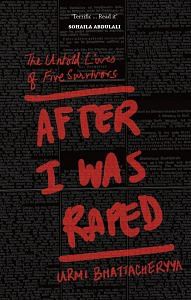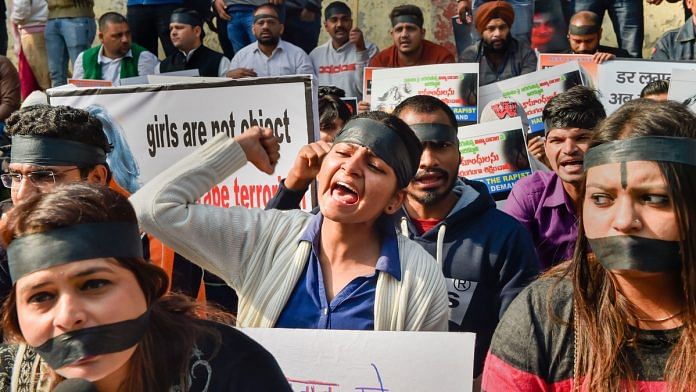Where does rape end? Where does it begin? Does it start somewhere between lulling oneself into a culturally conditioned haze – one that legitimizes male entitlement and the actual seizing of someone’s flesh? Does one take dry runs at stalking before perpetrating tangible assault on a body? Are there markers and metres between the grabbing and groping, the fondling and fleeing?
In a 1993 PhD thesis submitted to Portland State University, Urban Studies scholar Yaeko Steidel found that ‘dysfunctional parental relationships can be correlated with the acts of rapists’. Steidel speaks, among other things, of parental alienation at a time when the rapists in her control group were children and ‘consequently, they developed inferiority complexes and came to fear people, especially women’. Steidel’s study is almost thirty years old, but some of her findings have stayed with me to this day. I find them epochal, almost, of a cultural conditioning that seems both frozen in time and place, and unmoored to one time or place. I think, therefore, of rape that is born in adolescent minds. An idea of rape that begins to crystallize through tacit observations of social mores and patterns of behaviour – an idea that metamorphoses into action, watching grown men speak to grown women in rehearsed routines of condescension. The adolescent mind is prodded to think just as less of women, until finally, it thinks nothing of them at all. I think of rape that begins in impressing upon the crevices of the female body every infinitesimal male anxiety. I think of rape that is exhorted by watching others get away with it.
So that’s where rape begins. But where does it end? Media messaging will tell you that it ends in the silhouette of a single frosted palm cutting its way down a glass pane. It’ll tell you it ends in a news bulletin about a ‘Woman, aged X, raped by men or a man, aged Y’ – with aforementioned woman never to be heard of again. It’ll tell you it just does end this way.
Also read: I am a sexual abuse survivor. No, I am not a woman
There’s so much more to the story after the rape. That story can be found in the banding together of survivors; in their disgust at and eventual disillusionment with courts and cops; in the long, interminable wait for justice; in the countless therapy sessions and the ceaseless nightmares; in the changed relationships with one’s body and the transformed experiences of sex.
I’ve set out to trace all of this and more in a book that asks, ‘What after rape?’ I chose the experiences and stories of Nidhi, Meera, Ranjini, Pia and Smita (all names changed) to answer this question through accounts of their lives. They are by no means alike and their stories are in no way linear.
And why did I pick the stories of these five women?
Nidhi, an eight-year-old girl, was raped by a man she called bhaiyya, in an abyss by the railway tracks near her home; the sounds of her rape were drowned by the din of the train. She was four years old at the time.
Meera, a forty-year-old Dalit woman, lives in Dewas, Madhya Pradesh. She was raped because she is a Dalit, by a priest, she claims, who scaled a wall to wage a war against caste impropriety and ‘caste pool contamination’ by raping a woman who had dared to defy him. She was later subjected to the horrific, now-banned ‘two-finger test’ that calls for a medical professional to insert two fingers inside a woman’s vagina to determine its laxity and whether or not she is ‘habituated to sex’.
Ranjini, a thirty-eight-year-old Dalit woman lives in a nondescript hamlet in a tiny oasis of land on the Indore–Bhopal highway. She was raped, she claims, by a Gujjar chieftain in her village, while she was on her period, because she had refused to listen to his ‘orders’. She later chased her alleged rapist out of the village with a single soiled slipper, hurling verbal imprecations at him – partly in an attempt to convince her apathetic husband that she had not ‘invited’ the rape. Medical professionals blissfully and wilfully performed the two- finger test on her to confirm whether she was a ‘virgin’ or not. In case you missed it, she was raped for being Dalit.
Also read: No rakhis, suggesting marriage, discussing victim’s dress: New SC guide on sexual offence cases
Pia was the ‘eight-month-old baby’ who lived in reams of newsprint for longer than what was even her age at the time of the rape – seemingly immortalized for the fault of a man who raped her; the doctors had to seal a perineal tear between her anus and vagina and carve out a hole in her stomach for urine and excrement to pass through. The accused is her twenty-eight-year-old cousin.
Smita, now twenty-eight, inhabits a strange dream- like state for most hours of the day – in part from antidepressants to quell the nightmares born out of two rapes, and partly from the ceaseless loop of reliving and forgetting, loving (him) and hating (him), that she subjects herself to. Smita – soft-spoken, diminutive, self- deprecating – was raped twice, she alleges, by a man superior in rank to her at her workplace, whom she was in a relationship with, and then blackmailed, coerced and shamed. That shame – both for thinking of him, occasionally, and for ‘causing her own rape’ – continues to govern Smita’s consciousness and the way she thinks of herself. Today, she calibrates her life by the bruises on her breast that refuse to fade and by the feeblest affections from any man who claims to love her.
In October 2018, I called out my own abuser during the resurgence of the #MeToo movement in India. I wrote of the time he lay down next to me in my bed, uninvited, and groped my breasts and buttocks, as I was too intoxicated to protest. I wrote of the night at a dinner at his place, when he clambered on top of me and attempted to enter me. I fought him off that time, but I did ‘nothing’ back then, overridden by the shame of having ‘done nothing’ between the two molestations, having ‘allowed’ its occurrence, convinced that no one would believe me – or that everyone would disparage me, instead, for being the ‘kind of woman’ who got drunk; for being the ‘kind of woman’ who left herself in a vulnerable position; for being a woman who invited or signalled rape. I cried as I wrote about it and heard, in the bewildering haze that gathered over the next few months, the accounts of multiple women who had been abused and molested by the same man in years past, who were all determined to tell their stories.
Also read: Nirbhaya Fund underused, slotted for services that don’t help women directly — Oxfam report
It was years past the three-year statute of limitations on sexual harassment, but I complained anyway, compiling my story and theirs, and presenting it to the man’s workplace, demanding he be made to answer for his crimes. I’d like to believe that these five women I already knew from before that time, and multiple others, emboldened me to change the narrative that I had fed myself. I also understood something beautiful, changeless and omnipotent – that when one woman speaks up, countless follow; similarly emboldened to speak of the time that they, too, lost bodily autonomy.
I kept in touch with these five women over the years, investigating the tiniest aspects of their stories, following up on their legal journeys and asking after their mental health. After I Was Raped picks up where most news reports about survivors leave off – it enters bedrooms and courtrooms, and picks up the threads of their lives today, years after their rape, and in the midst of their continuing wait for justice. It does so through the friendships I cemented with them, over the years. Therefore, you will notice that the book is in the first person; I write of these five survivors ‘in real time’ as I visit and interact with them, and I have done so to help facilitate relatability with the reader.
 This excerpt from ‘After I Was Raped: The Untold Lives of Five Survivors’ by Urmi Bhattacheryya has been published with permission from PanMacmillan India.
This excerpt from ‘After I Was Raped: The Untold Lives of Five Survivors’ by Urmi Bhattacheryya has been published with permission from PanMacmillan India.



